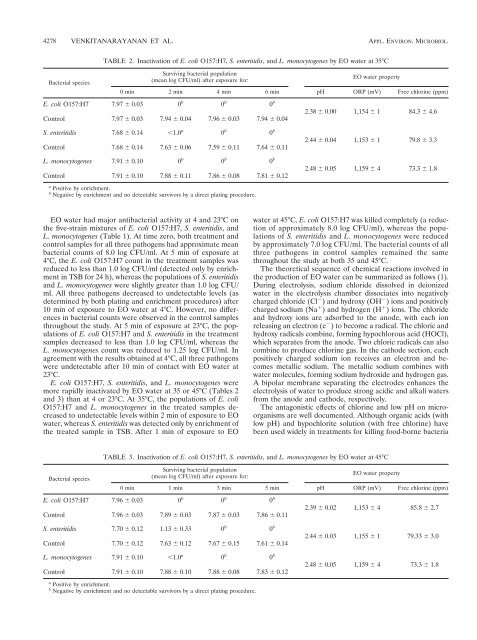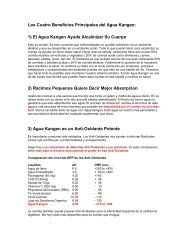ACID-ALKALINE BALANCE: ROLE IN CHRONIC ... - My Kangen Tools
ACID-ALKALINE BALANCE: ROLE IN CHRONIC ... - My Kangen Tools
ACID-ALKALINE BALANCE: ROLE IN CHRONIC ... - My Kangen Tools
Create successful ePaper yourself
Turn your PDF publications into a flip-book with our unique Google optimized e-Paper software.
4278 VENKITANARAYANAN ET AL. APPL. ENVIRON. MICROBIOL.<br />
TABLE 2. Inactivation of E. coli O157:H7, S. enteritidis, and L. monocytogenes by EO water at 35°C<br />
Bacterial species<br />
Surviving bacterial population<br />
(mean log CFU/ml) after exposure for:<br />
EO water property<br />
0 min 2 min 4 min 6 min pH ORP (mV) Free chlorine (ppm)<br />
E. coli O157:H7 7.97 0.03 0 b 0 b 0 b 2.38 0.00 1,154 1 84.3 4.6<br />
Control 7.97 0.03 7.94 0.04 7.96 0.03 7.94 0.04<br />
S. enteritidis 7.68 0.14 1.0 a 0 b 0 b 2.44 0.04 1,153 1 79.8 3.3<br />
Control 7.68 0.14 7.63 0.06 7.59 0.11 7.64 0.11<br />
L. monocytogenes 7.91 0.10 0 b 0 b 0 b 2.48 0.05 1,159 4 73.3 1.8<br />
Control 7.91 0.10 7.88 0.11 7.86 0.08 7.81 0.12<br />
a Positive by enrichment.<br />
b Negative by enrichment and no detectable survivors by a direct plating procedure.<br />
EO water had major antibacterial activity at 4 and 23°C on<br />
the five-strain mixtures of E. coli O157:H7, S. enteritidis, and<br />
L. monocytogenes (Table 1). At time zero, both treatment and<br />
control samples for all three pathogens had approximate mean<br />
bacterial counts of 8.0 log CFU/ml. At 5 min of exposure at<br />
4°C, the E. coli O157:H7 count in the treatment samples was<br />
reduced to less than 1.0 log CFU/ml (detected only by enrichment<br />
in TSB for 24 h), whereas the populations of S. enteritidis<br />
and L. monocytogenes were slightly greater than 1.0 log CFU/<br />
ml. All three pathogens decreased to undetectable levels (as<br />
determined by both plating and enrichment procedures) after<br />
10 min of exposure to EO water at 4°C. However, no differences<br />
in bacterial counts were observed in the control samples<br />
throughout the study. At 5 min of exposure at 23°C, the populations<br />
of E. coli O157:H7 and S. enteritidis in the treatment<br />
samples decreased to less than 1.0 log CFU/ml, whereas the<br />
L. monocytogenes count was reduced to 1.25 log CFU/ml. In<br />
agreement with the results obtained at 4°C, all three pathogens<br />
were undetectable after 10 min of contact with EO water at<br />
23°C.<br />
E. coli O157:H7, S. enteritidis, and L. monocytogenes were<br />
more rapidly inactivated by EO water at 35 or 45°C (Tables 2<br />
and 3) than at 4 or 23°C. At 35°C, the populations of E. coli<br />
O157:H7 and L. monocytogenes in the treated samples decreased<br />
to undetectable levels within 2 min of exposure to EO<br />
water, whereas S. enteritidis was detected only by enrichment of<br />
the treated sample in TSB. After 1 min of exposure to EO<br />
water at 45°C, E. coli O157:H7 was killed completely (a reduction<br />
of approximately 8.0 log CFU/ml), whereas the populations<br />
of S. enteritidis and L. monocytogenes were reduced<br />
by approximately 7.0 log CFU/ml. The bacterial counts of all<br />
three pathogens in control samples remained the same<br />
throughout the study at both 35 and 45°C.<br />
The theoretical sequence of chemical reactions involved in<br />
the production of EO water can be summarized as follows (1).<br />
During electrolysis, sodium chloride dissolved in deionized<br />
water in the electrolysis chamber dissociates into negatively<br />
charged chloride (Cl ) and hydroxy (OH ) ions and positively<br />
charged sodium (Na ) and hydrogen (H ) ions. The chloride<br />
and hydroxy ions are adsorbed to the anode, with each ion<br />
releasing an electron (e ) to become a radical. The chloric and<br />
hydroxy radicals combine, forming hypochlorous acid (HOCl),<br />
which separates from the anode. Two chloric radicals can also<br />
combine to produce chlorine gas. In the cathode section, each<br />
positively charged sodium ion receives an electron and becomes<br />
metallic sodium. The metallic sodium combines with<br />
water molecules, forming sodium hydroxide and hydrogen gas.<br />
A bipolar membrane separating the electrodes enhances the<br />
electrolysis of water to produce strong acidic and alkali waters<br />
from the anode and cathode, respectively.<br />
The antagonistic effects of chlorine and low pH on microorganisms<br />
are well documented. Although organic acids (with<br />
low pH) and hypochlorite solution (with free chlorine) have<br />
been used widely in treatments for killing food-borne bacteria<br />
TABLE 3. Inactivation of E. coli O157:H7, S. enteritidis, and L. monocytogenes by EO water at 45°C<br />
Bacterial species<br />
Surviving bacterial population<br />
(mean log CFU/ml) after exposure for:<br />
EO water property<br />
0 min 1 min 3 min 5 min pH ORP (mV) Free chlorine (ppm)<br />
E. coli O157:H7 7.96 0.03 0 b 0 b 0 b 2.39 0.02 1,153 4 85.8 2.7<br />
Control 7.96 0.03 7.89 0.03 7.87 0.03 7.86 0.11<br />
S. enteritidis 7.70 0.12 1.13 0.33 0 b 0 b 2.44 0.03 1,155 1 79.33 3.0<br />
Control 7.70 0.12 7.63 0.12 7.67 0.15 7.61 0.14<br />
L. monocytogenes 7.91 0.10 1.0 a 0 b 0 b 2.48 0.05 1,159 4 73.3 1.8<br />
Control 7.91 0.10 7.88 0.10 7.88 0.08 7.83 0.12<br />
a Positive by enrichment.<br />
b Negative by enrichment and no detectable survivors by a direct plating procedure.



